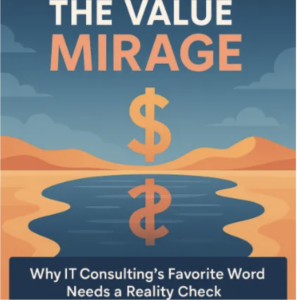“Value” might just be the most overworked word in the consulting lexicon. It’s plastered across PowerPoint decks with the frequency of wallpaper patterns, mumbled in boardrooms, and promised in every proposal. But much like that friend who constantly vows to call you back, the follow-through often leaves something to be desired.
Let’s be honest: every IT consulting engagement comes wrapped in the rhetoric of “delivering value” or “unlocking value” or perhaps “maximising value.” It’s the mantra chanted in corporate hallways everywhere. Yet when the consultants pack their bags and the invoices get paid, a peculiar phenomenon occurs. Value can no longer be found.
Consider this head-scratching statistic: a whopping 92% of executives claim their most recent consulting project was successful, yet only about half rehire the same firm. It’s the corporate equivalent of giving a restaurant five stars on Yelp and then never returning. If the value delivered was so spectacular, why aren’t these consultants on speed dial for the next initiative?
The answer lies in that troublesome gap between rhetoric and reality. Talk of value flows freely; actual, measurable improvement arrives more sporadically.
The three flavours of value nobody talks about
When we peel back the layers, “value” in IT projects manifests in three distinct dimensions, each playing a critical role in whether your million-dollar initiative becomes a triumph or an expensive lesson.
Financial value is the straightforward one, the kind CFOs adore and spreadsheets showcase. Amazon discovered every 100ms of website latency cost them 1% in sales. UPS saved hundreds of millions annually through route optimization with their ORION project, eliminating unnecessary left turns and reducing fuel consumption by 10 million gallons per year. That’s cold, hard cash value you can literally take to the bank.
Social value represents the benefits brought to people, whether customers or employees. When UK retailer Tesco collaborated with the Royal National Institute of Blind People to create an accessible grocery website, online sales skyrocketed in just one year. Legal & General similarly updated their site for accessibility and watched traffic jump by 25–50%. Turns out, making your digital properties more inclusive isn’t just good karma; it’s good business.
Then there’s the elephant in the room: political value. This is the awkward cousin nobody mentions at family gatherings, yet it drives countless project approvals. Sometimes a project’s true “value” lies in who championed it or which faction of the organisation it empowers. Perhaps it aligns with the CEO’s vision after a particularly inspirational conference keynote. Maybe it serves as a tenuous peace treaty between warring departments. Or, as one columnist noted,“a project objective might be more about satisfying an executive’s whim than implementing a strategy or fulfilling the company mission.”
Why The Value Theatre continues
Given how vital genuine value is, one might wonder why so many projects end up in the “value theatre” category. Global businesses poured roughly $1.3 trillion into digital transformation in a recent year, and according to Harvard Business Review, about $900 billion evaporated with little to show for it.
Two culprits stand out in this expensive tragedy.
First, an astonishing number of projects kick off without understanding who the users are or what problem needs solving. A UK Government analysis found that misunderstanding user needs was the single biggest factor in failed digital projects. The lack of user involvement and incomplete requirements are the top reasons IT projects fail. It’s remarkably difficult to deliver value when you’re building the wrong thing for the wrong people.
Second, many initiatives lack genuine business alignment. They exist because someone important wanted them to exist, not because they solve a pressing problem or advance a coherent strategy. The Institute of Industrial and Systems Engineers found that many IT projects fail simply because they were never truly aligned with business strategy to begin with, they were solutions chasing a problem.
Perhaps most telling is how we measure success. Anywhere from 50% to 70% of IT projects don’t achieve their intended outcomes. However, most companies prefer to pay consultants without tying fees to actual results and only a minority consider meeting project objectives a critical success factor. When payment isn’t linked to outcomes, and achieving goals isn’t even paramount, it’s little wonder nearly every project can be declared “successful” regardless of whether anything actually improved.
The Value paradox
Here’s where things get strange. Value isn’t one-size-fits-all; it’s contextual to the point of being slippery. As one industry commentator put it, “Value as a word doesn’t mean anything. It’s a placeholder, a catchphrase for something dynamic, contextual and requiring acknowledgement from others.”
A data analytics platform might revolutionize one company while becoming expensive digital furniture at another. The same cloud migration could be a game-changer for a growing enterprise and a costly boondoggle for a stable legacy business.
This contextual nature of value creates a trap. Since “value” can mean almost anything, it’s easy for both consultants and clients to fall back on vague promises of “enhancing agility” or “driving digital transformation” without pinning down what success actually looks like in measurable terms.
Closing the value gap
Moving beyond value theater requires uncomfortable honesty from both sides of the consulting table.
First, we need to define success in terms specific to the client’s situation, whether that’s customer retention, faster time-to-market, or operational resilience.
Second, methodology must become transparent rather than mysterious. Don’t just drop buzzwords like “agile” and “design thinking”; explain exactly what you’re doing, how you’re doing it, and what concrete outcomes the client should expect.
Third, impact assessment must extend well beyond the go-live party. Track outcomes for months or years after project completion.
Perhaps most importantly, more consulting engagements should incorporate outcome-based compensation. When consultants have skin in the game, their focus tends to sharpen remarkably. Even without formal performance-based pricing, having explicit conversations about value metrics keeps projects centred on results rather than just checking boxes.
From theatre to truth
The stakes here aren’t trivial. In his classic hierarchy of consulting purposes, Arthur Turner argued that lasting value comes not from solving one-off problems but from building client capability and organizational effectiveness.
Yet many engagements aim far lower. The PowerPoint gets presented, the invoice gets paid, and the organization is left wondering how to implement recommendations that looked brilliant in the slide deck but prove bewildering in practice.
Every hour of consultant effort has no inherent value; only the benefits that work produces merit a reward. You could spend 100 hours crafting the most elegant IT strategy imaginable, but if nobody implements it, that’s 100 hours of “value” evaporated into the corporate ether.
Value matters because it’s the only thing that justifies those hefty consulting fees. It’s what separates transformational partnerships from glorified staff augmentation. When consultants are held accountable to outcomes and clients stay engaged beyond the kickoff meeting, “value” transforms from tired jargon into measurable improvement.
So the next time someone proposes a new system “because we need to innovate,” try asking, “What kind of value will it actually deliver, and how will we know?” The blank stares might be uncomfortable at first, but they’re the beginning of a more honest conversation.
The V-word deserves better than being reduced to corporate wallpaper. It’s time to put value back in its rightful place: as something concrete we plan for, measure, and genuinely deliver, not just preach about. The age of value theatre needs to end. We need to move from a mirage of value to actual measurable value whether financial, social or political.
— — —
The Value Mirage Series
Part I : The Value Theatre
Part II : Beyond The Value Theatre
Part III : Framing Value



